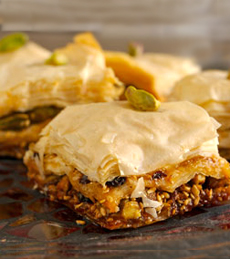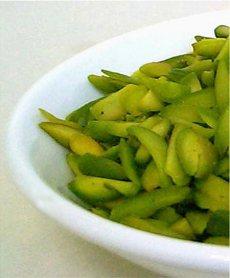

Baklava is a delicious dessert with any cuisine, and a wonderful brunch pastry. Photo courtesy Recchiuti Confections.
April 2008
Last Updated November 2013
|
 |
Recipe: Baklava
A Greek & Turkish Favorite You’ll Enjoy Making At Home
Our eyes brighten whenever we see baklava on a menu: thin, crisp sheets of Greek phyllo dough, interleafed with honey and chopped pistachio nuts, gently spiced with allspice and rosewater. Now we can make them at home, with this recipe from San Francisco chocolatier and patissier Michael Recchiuti. Making baklava can be enjoyable with a friend: You need to work fast to keep the phyllo moist, and four hands work quicker than two!
The History Of Baklava
The earliest form of the pastry was made in the 8th century B.C.E. in northern Mesopotamia, when the Assyrians layered very thin pieces of dough with nuts and honey, and baked them in wood-burning ovens. Greek seamen brought the concept home.*
Athenian artisan bakers created phyllo, the leaf-thin layers of dough; and as early as the 3rd century B.C., the modern prototype of baklava was served in wealthy Greek households for special occasions. Other nations adapted the recipe: Armenians added cinnamon and cloves, Arabs added rosewater and cardamom. The pastry spread to the households of wealthy Persians and Romans; in the 4th Century C.E., when the Roman Empire expanded to Byzantium (modern Turkey), so did baklava. A Mediterranean favorite, it is easy to see why every country would want to claim baklava as its own!
*Historical information courtesy of SinbadSweets.com.
We know that baklava was baked in the kitchens of the The Topkapi Palace in Istanbul, Turkey—the residence of the Ottoman Sultans from 1465 to 1853. The pastry is part of the cuisines of many of the 25 former Ottoman Empire countries, which included Albania, Bosnia, Bulgaria, Crete, Cyprus, Greece, Herzegovina, Hungary, Moldavia and Serbia. The Empire was finally dissolved in 1922, but delicious baklava remains for all to enjoy.
Baklava Recipe Ingredients
Syrup
- 1-¾ cups granulated cane sugar
- 1 teaspoon lemon juice
- 1-½ cups spring water
- ½ teaspoon freshly ground allspice
- 1 tablespoon rosewater
- 1 tablespoon orange blossom water
Filling
- 1/3 cup sesame seeds
- 1-½ cups pistachios, unsalted and lightly toasted
(pistachios are the traditional nuts of the Middle East, but
you can substitute walnuts)
- 1/3 cup dried currants
- 6 tablespoons granulated cane sugar
- ½ teaspoons freshly ground cinnamon
- ½ teaspoon freshly grated nutmeg
- 1/8 teaspoon fleur de sel
- 1½ cups clarified butter, melted
- 1 pound phyllo pastry (one package at room temperature)
Preparation
Make The Syrup
- Dissolve the sugar in the lemon juice and water in a saucepan over medium heat. Simmer for 10 minutes.
- Remove from the heat and whisk in the allspice, rosewater and orange blossom water. Let cool completely.
Make The Filling
- Preheat the oven to 350°F. Coat the bottom and sides of a 9-by-9 inch square baking dish with butter.
- Melt 3 tablespoons of the clarified butter in a sauté pan over medium heat. Add the sesame seeds and sauté until golden brown, stirring frequently.
- Remove from the heat and add the pistachios, currants, sugar, cinnamon, nutmeg and fleur de sel. Stir to combine. Set aside.
|
|

Every ingredient in the recipe contributes to making it a success. Don’t look for the cheapest pistachios, look for the best. These gourmet pistachio nuts from Pariya Foods will do the trick. Other favorites come from Santa Barbara Pistachios. Both are NIBBLE Top Picks Of The Week. |
Assemble
- Over low heat, melt the remaining clarified butter in a saucepan.
- Carefully roll open the phyllo dough. Cut the sheets in half, crosswise. Stack the dough sheets on top of each other, cover with a sheet of plastic wrap and place a damp cloth on top. This will keep the dough from drying out while you are assembling the layers. Phyllo dough is best handled when slightly moist, but not soggy.
- Place two sheets of the dough in the bottom of the buttered pan. Re-cover the stacked dough to keep it from drying and repeat this process throughout the assembly.
- Using a pastry brush, brush the surface of the dough with the melted butter. Add two more sheets of dough and apply another coat of butter. Continue until you have a total of eight layers.
- Using a spoon, evenly spread half of the filling over the surface of the dough layers. Add eight more layers of dough and butter. Spread the remaining filling over this layer and cover with eight more layers of dough. Brush the top layer of the dough with the remaining butter.
- Using a sharp knife and being careful not to distort the layers, cut the baklava into 2-inch squares. Bake on the middle shelves of the oven for 30 minutes. Lower the heat to 300°F and bake for an additional 45 to 50 minutes until the surface is a deep golden color.
- Remove from the oven and let cool for a few minutes. Pour the syrup evenly over the top and set aside to cool completely.
- Store in an airtight container at room temperature for up to one week. Makes 16 pieces.
Recipe © copyright Recchiuti Confections. Other written material

|





